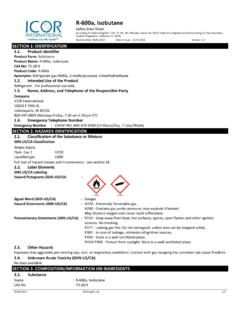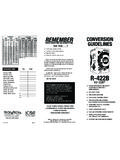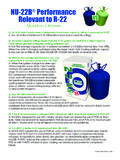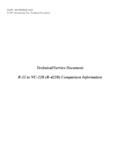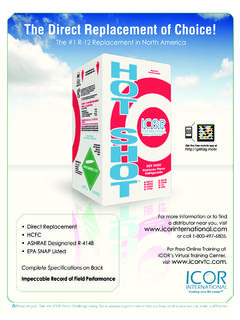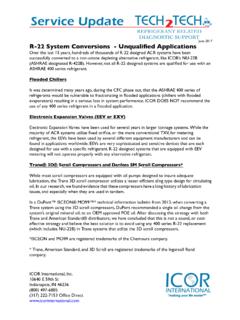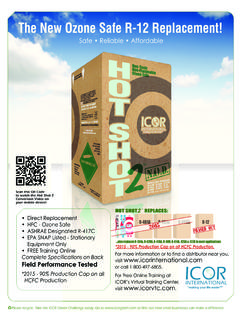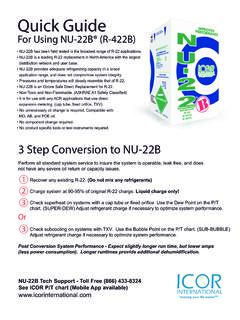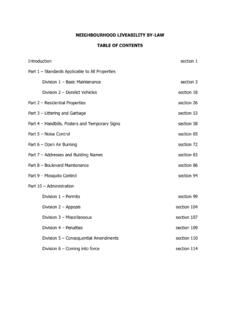Transcription of NU-22B® (R-422B) - ICOR International
1 NU-22B (R-422B) Safety Data Sheet according to Federal Register / Vol. 77, No. 58 / Monday, March 26, 2012 / Rules and Regulations Revision Date: 08/30/16 Date of issue: 08/30/16 Version: EN (English US) 1/7 SECTION 1: IDENTIFICATION Product Identifier Product Form: Mixture Product Name: NU-22B (R-422B) Intended Use of the Product Refrigerant Name, Address, and Telephone of the Responsible Party Company ICOR International 10640 E 59th St. Indianapolis, IN 46236 800-497-6805 (Monday-Friday, 7:30 am-4:30 pm ET)Emergency Telephone NumberEmergency number : CHEMTREC 800-424-9300 (24 Hours/Day, 7 Days/Week) SECTION 2: HAZARDS IDENTIFICATION Classification of the Substance or Mixture Classification (GHS-US) Simple Asphyxiant Liquefied gas H280 Label Elements GHS-US Labeling Hazard Pictograms (GHS-US) : GHS04 Signal Word (GHS-US) : Warning Hazard Statements (GHS-US) : H280 - Contains gas under pressure; may explode if heated May displace oxygen and cause rapid suffocation Precautionary Statements (GHS-US) : P410+P403 - Protect from sunlight.
2 Store in a well-ventilated place Other Hazards Other Hazards Not Contributing to the Classification: Exposure may aggravate those with pre-existing eye, skin, or respiratory conditions. Liquid contact with eyes or skin may cause frostbite. Unknown Acute Toxicity (GHS-US) Not available SECTION 3: COMPOSITION/INFORMATION ON INGREDIENTS Substances Name Product identifier % (w/w) Classification (GHS-US) Pentafluoroethane (HFC125) (CAS No) 354-33-6 55 Simple Asphyxiant Liquefied gas, H280 1,1,1,2-Tetrafluoroethane (HFC-134a) (CAS No) 811-97-2 42 Simple Asphyxiant Liquefied gas, H280 Isobutane (HC-600a) (CAS No) 75-28-5 3 Simple Asphyxiant Flam. Gas 1, H220 Liquefied gas, H280 Full text of H-phrases: see section 16 SECTION 4: FIRST AID MEASURES Description of First Aid Measures General: Never give anything by mouth to an unconscious person.
3 If you feel unwell, seek medical advice (show the label if possible). NU-22B (R-422B) Safety Data Sheetaccording to Federal Register / Vol. 77, No. 58 / Monday, March 26, 2012 / Rules and Regulations 08/30/16 EN (English US) 2/7 Inhalation: Remove to fresh air and keep at rest in a position comfortable for breathing. Obtain medical attention if breathing difficulty persists. Skin Contact: Rinse immediately with plenty of water. Obtain medical attention if irritation develops or persists. Eye Contact: Rinse cautiously with water for at least 15 minutes. Remove contact lenses, if present and easy to do. Continue rinsing. Obtain medical attention. Ingestion: Do NOT induce vomiting. Rinse mouth.
4 Immediately call a POISON CENTER or doctor/physician. Most Important Symptoms and Effects Both Acute and Delayed General: Vapors are heavier than air and may cause asphyxia by reduction of the oxygen content. Inhalation: May cause respiratory irritation. Skin Contact: May cause skin irritation. Liquid contact may cause frostbite. Eye Contact: May cause eye irritation. Ingestion: Ingestion is likely to be harmful or have adverse effects. Chronic Symptoms: None expected under normal conditions of use. Indication of Any Immediate Medical Attention and Special Treatment Needed If you feel unwell, seek medical advice (show the label where possible). SECTION 5: FIRE-FIGHTING MEASURES Extinguishing Media Special Hazards Arising From the Substance or Mixture Advice for Firefighters Precautionary Measures Fire: Exercise caution when fighting any chemical fire.
5 Firefighting Instructions: Use water spray or fog for cooling exposed containers. Protection During Firefighting: Do not enter fire area without proper protective equipment, including respiratory protection. Hazardous Combustion Products: Carbon oxides (CO, CO2). Halogenated hydrocarbons. Hydrogen Fluoride (HF). Reference to Other Sections Refer to section 9 for flammability properties. SECTION 6: ACCIDENTAL RELEASE MEASURES Personal Precautions, Protective Equipment and Emergency Procedures General Measures: Avoid all contact with skin, eyes, or clothing. Avoid breathing vapors. For Non-Emergency Personnel Protective Equipment: Use appropriate personal protection equipment (PPE).
6 Emergency Procedures: Evacuate unnecessary personnel. For Emergency Personnel Protective Equipment: Equip cleanup crew with proper protection. Emergency Procedures: Stop leak if safe to do so. Ventilate area. Environmental Precautions Avoid release to the environment. Methods and Material for Containment and Cleaning Up For Containment: Ventilate area. Methods for Cleaning Up: Isolate area until gas has dispersed. Reference to Other Sections See Heading 8. Exposure controls and personal protection. Suitable Extinguishing Media: Use extinguishing media appropriate for surrounding fire. Unsuitable Extinguishing Media: None known. Fire Hazard: NU-22B is not flammable at atmospheric pressure and in air at temperatures up to 100 C (212 F).
7 NU-22B should not exist with air/excess oxygen at elevated pressures and high temperatures. NU-22B can become combustible with high concentrations of air at elevated pressure and/or temperature and in the presence of an ignition source. Theis substance can also become combustible in an oxygen enriched environment (oxygen concentrations greater tha that in air). For example, do not mix NU-22B with air under pressure for leak detection purposes. Explosion Hazard: Product is not explosive. Heat may build pressure, rupturing closed containers, spreading fire and increasing risk of burns and injuries. Reactivity: Hazardous reactions will not occur under normal conditions. NU-22B (R-422B) Safety Data Sheetaccording to Federal Register / Vol.
8 77, No. 58 / Monday, March 26, 2012 / Rules and Regulations 08/30/16 EN (English US) 3/7 SECTION 7: HANDLING AND STORAGE Precautions for Safe Handling Additional Hazards When Processed: Ruptured cylinders may rocket. Hygiene Measures: Handle in accordance with good industrial hygiene and safety procedures. Wash hands and other exposed areas with mild soap and water before eating, drinking or smoking and when leaving work. Conditions for Safe Storage, Including Any Incompatibilities Technical Measures: Comply with applicable regulations. Storage Conditions: Store in a dry, cool and well-ventilated place. Keep container closed when not in use. Keep/Store away from direct sunlight, extremely high or low temperatures and incompatible materials.
9 Incompatible Materials: Strong acids. Strong bases. Strong oxidizers. Chlorine. Storage Area: Store in a well-ventilated place. Specific End Use(s) Refrigerant. SECTION 8: EXPOSURE CONTROLS/PERSONAL PROTECTION Control Parameters Isobutane (HC-600a) (75-28-5) USA ACGIH ACGIH STEL (ppm) 1000 ppm USA NIOSH NIOSH REL (TWA) (mg/m ) 1900 mg/m USA NIOSH NIOSH REL (TWA) (ppm) 800 ppm Manitoba OEL STEL (ppm) 1000 ppm Newfoundland & Labrador OEL STEL (ppm) 1000 ppm Nova Scotia OEL STEL (ppm) 1000 ppm Ontario OEL TWA (ppm) 800 ppm Prince Edward Island OEL STEL (ppm) 1000 ppm Saskatchewan OEL STEL (ppm) 1250 ppm Saskatchewan OEL TWA (ppm) 1000 ppm Pentafluoroethane (HFC125) (354-33-6) ICOR AEL* OEL 8 & 12 hr TWA (ppm) 1000 ppm AIHA WEEL OEL 8 hr TWA 1000 ppm, 4900 mg/m3 1,1,1,2-Tetrafluoroethane (HFC-134a) (811-97-2) ICOR AEL* OEL 8 & 12 hr TWA (ppm)
10 1000 ppm AIHA WEEL OEL 8 hr TWA 1000 ppm, 4900 mg/m3 * ICOR acceptable Exposure Limit. ICOR reviews industry standards and recommendations in consideration of acceptable exposurelimitations. Where regulated exposure limits are lower than ICOR s recommended AEL, those limits shall ControlsAppropriate Engineering Controls: Ensure adequate ventilation, especially in confined areas. Ensure all national/local regulationsare Protective Equipment: Protective goggles. Gloves. Protective for Protective Clothing: Chemically resistant materials and fabrics. Hand Protection: Impervious butyl rubber gloves. Eye Protection: Chemical goggles or safety glasses. Skin and Body Protection: Wear suitable protective clothing.
